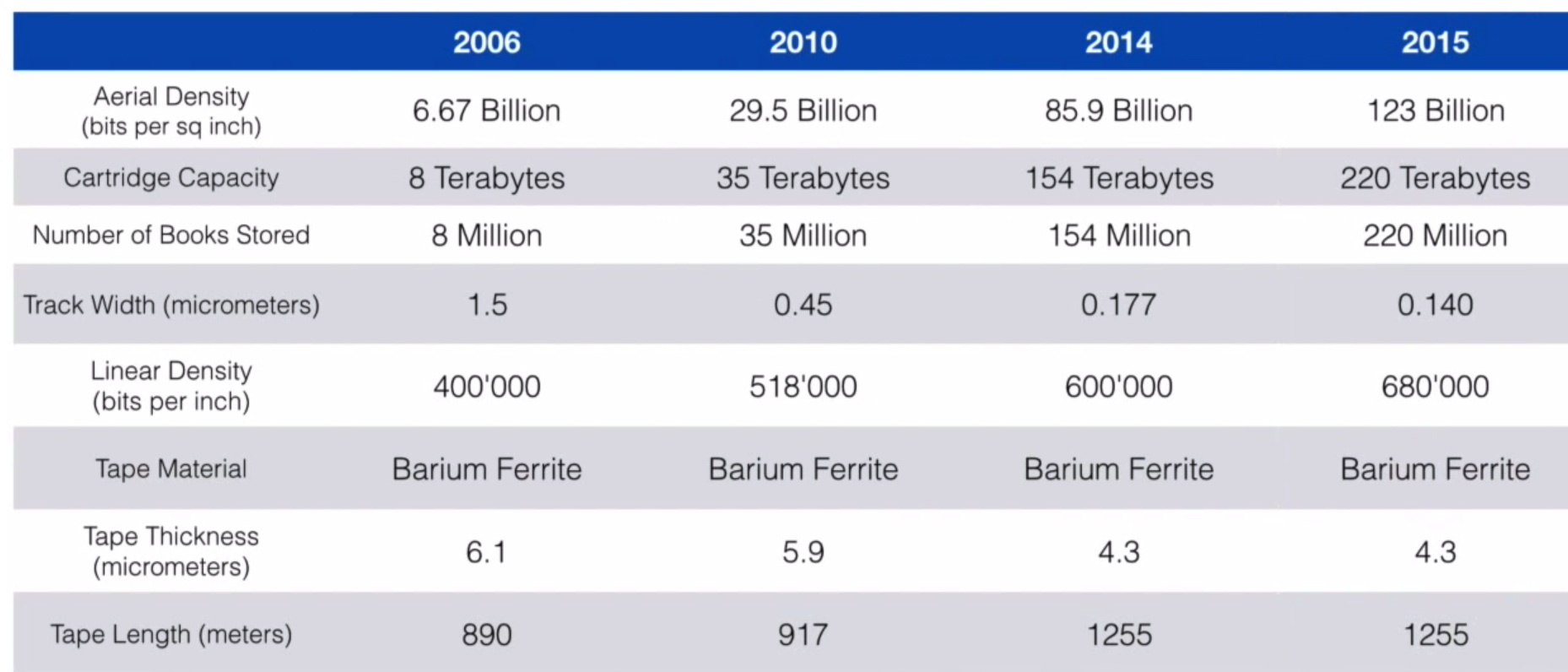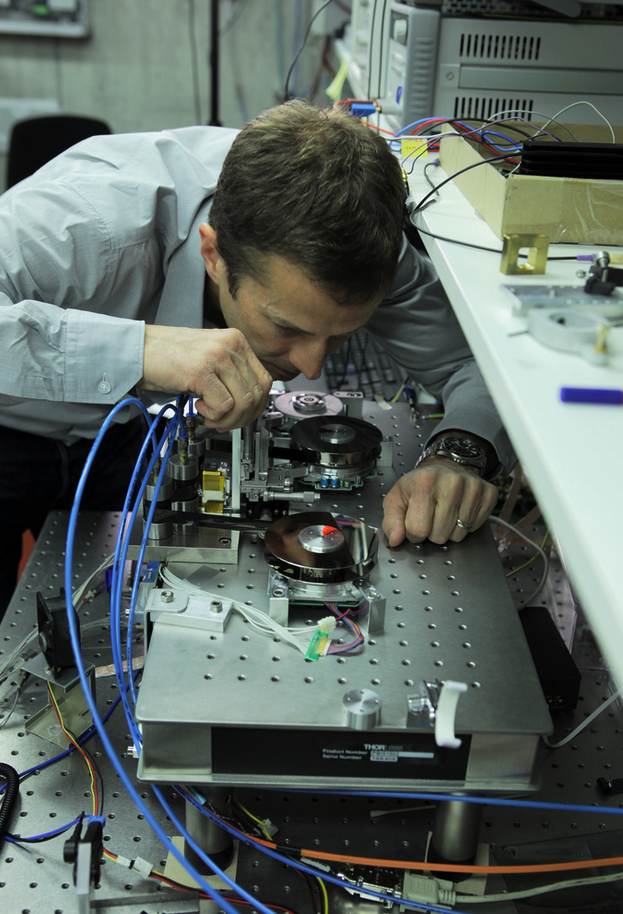Prototype of Tape Cartridge at Record Uncompressed 220TB By Fujifilm and IBM
But when on the market?
This is a Press Release edited by StorageNewsletter.com on April 13, 2015 at 2:48 pmFujifilm Recording Media U.S.A., Inc., a subsidiary of Fujifilm Corporation, manufacturer of storage media, announced that in conjunction with IBM Corp., a new record in areal data density of 123 billion bits per square inch on linear magnetic particulate tape has been achieved.
For the fourth time in less than 10 years, the two companies have accomplished record breaking storage capacities on tape; announcing the highest capacity storage media ever achieved, including HDD, BD or solid memory NAND flash technologies. This breakthrough in data density equates to a single tape cartridge capable of storing up to 220TB of uncompressed data. 220TB is more than 88 times the storage capacity of the current LTO Ultrium 6 tape.
A tape of this size can provide enough storage to preserve the human genome of 220 people on a single cartridge.
“With HPC and cloud storage services on the rise, this data density achievement is significant,” said Peter Faulhaber, president, Fujifilm Recording Media USA. “Fujifilm and IBM are leading the technological development of advanced tape innovation that meets the market’s growing data requiremens and delivers tape as the medium of coice for archival storage.”
This record breaking demonstration was achieved using an advanced prototype tape incorporating Nanocubic technology developed by Fujifilm, with advanced tape-drive technologies developed by IBM.
Fujifilm Technology Enhancements
Fujifilm’s Nanocubic technology is enhanced to increase recording density by decreasing the magnetic particle size that is essential for high recording density. Fujifilm’s original BaFe synthesis method increases the uniformity of BaFe particle size and decreases 25% of the switching field distribution (SFD), which is an important magnetic parameter for high density recording. The lower SFD leads to a high quality signal output due to the uniform magnetic property of each recorded bit. To ensure the stability of the ultra-fine BaFe particles, Fujifilm improved the magnetic coercivity, yielding an archival life of over 30 years.
A highly controlled dispersion process and newly developed chemical compound allows the BaFe particles to separate and disperse more uniformly and increases the perpendicular oriented ratio. Perpendicular orientation technology with BaFe produces a high signal to noise ratio and better frequency response. Enhanced Nano coating technology with a very smooth non-magnetic layer controls the tape surface roughness, providing a smooth magnetic layer for higher signal output. Fujifilm’s advanced servo writing technology decreases high frequency vibration of the servo tracks and enables a higher track density due to more precisely placed servo tracks.
IBM Technology Enhancements
- A set of advanced servo control technologies that enable more accurate head positioning and increased track density.
- An enhanced write field head technology that enables the use of much finer barium ferrite particles.
- Innovative signal-processing algorithms for the data channel that enable reliable operation with an ultra-narrow 90nm wide GMR reader.
Comments
Historically, the first tape drive for a computer was the UNISERVO from Remington Rand, Inc.'s Eckert-Mauchly Division. One year later IBM launched in May 21, 1952 its first unit, the model 726 Magnetic Tape Reader/Recorder, launched May 21, 1952 with an initial capacity of about 2MB per reel, four years before the first HDD, IBM Ramac, at 5MB.
The areal density demonstration announced in the above press release represents a potential increase in capacity of 110,000,000 times compared with IBM's first tape drive product.
Today more than 500EB of data reside in tape storage systems, according to IT analyst firm Coughlin Associates.
Tape media and heads are the key elements to improve te performance of longitudinal magnetic tape media. That's why IBM, manufacturer of tape drives, including heads and all the mechanism associated, and Fujifilm, in tape media, are collaborating since many years to enhance their common solution.
Since 2002, IBM has been working closely with Fujifilm, particularly on the optimization of its dual-coat magnetic tape based on barium ferrite (BaFe) particles. The results of this collaboration have led to various technology improvements, among them a dramatic increase in the precision of controlling the position of the read-write heads which has resulted in an increase in the number of tracks that can be squeezed onto half-inch-wide tape.
Both companies are working together to apply their technologies to mid-range LTO and high-end 3592 formats.
Today, the record native capacity of LTO, now generation 6, is 2.5TB with 160MB/s transfer rate and the possibility to increase these numbers with 2.5:1 data compression. For the media, Fujifilm uses Barium Ferrite magnetic particles with its own core Nanocubic thin-film coating process. Generations 7, 8, 9 and 10 added to the LTO product roadmap, call for native capacities of 6.4TB (315MB/s), 12.8TB (472MB/s) 25TB (708MB/s) for generation 9 and 148TB (1,100MB/s) for generation 10, respectively, all with 2.5:1 compression. IBM and HP manufacture the drives.
The fifth generation of IBM 3592 tape cartridge technology, the TS1150, was announced on October 2014 at native 10TB and 360MB/s or a 150% increase in capacity and 44% in data rate compared to the previous TS1140 released five years ago. That's better specs that the current Oracle StorageTek T10000D tape drive released two years ago with native 8.5TB/cartridge and transfer rate of 252MB/s. In IBM's roadmap, sixth generation of IBM 3592, probably in around two years, is supposed to be between 14TB and 20TB, and at 540MB/s.
The Fujifilm/IBM prototype is killing current available technologies with uncompressed 220TB, 88X the capacity of current LTO and 22X the IBM TS1150.
The 220TB media achieves an areal density of 123 billion bits per square inch with 680,000bpi linear density and 181,300tpi track density on a tape 4.3μm thick and 1,255m length, with a track width of 140nm.
The engineers demonstrated a track-follow performance with a standard deviation of only 5.9nm from the target track position.
IBM scientist Mark Lentz working on new tape technology
Researchers developed here several new technologies, including:
- A set of advanced servo control technologies that include a high bandwidth head actuator, a servo pattern and servo channel and a set of tape speed optimized H-infinity track follow controllers
- An enhanced write field head technology that enables the use of much finer BaFe particles.
- Signal-processing algorithms for the data channel, based on noise-predictive detection principles, enable reliable operation with an ultra narrow 90nm wide GMR reader.
- A new prototype low-noise tape transport system
- A prototype high-bandwidth track following actuator
- An advanced set of tape speed optimized H-infinity based track follow controller.
Developed by Fujifilm in Japan in collaboration with IBM research scientists, the enhanced next-generation Nanocubic tape incorporates nano coating and dispersion technology and ultrafine, perpendicularly-oriented BaFe particles enabling high-density data recording without using expensive metal sputtering or evaporation coating methods.
A new data channel combines a timing recovery scheme and novel variations of noise-predictive, maximum-likelihood (NPML) detection schemes and a new iterative decoding scheme. This combination of technologies ensures the same user bit error rate performance as is achieved with the latest IBM enterprise tape drive despite the reduction in reader width and increase in linear density.
IBM's Tale of the Tape
(not announced products)
(Source: IBM)
But IBM and Fujifilm didn't say:
- when any products will be available - several tape prototypes never reach production and, in the table above, we are just now with the specs of prototypes revealed in ... 2006
- if the technology will be for LTO of IBM3592 - IBM speaks about half-inch tape used by both format
If it's for LTO, it will be something like generation 11 in around ten years, and maybe less if applied to 3592 format.













 Subscribe to our free daily newsletter
Subscribe to our free daily newsletter
